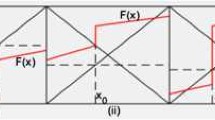Abstract
Calmness of multifunctions is a well-studied concept of generalized continuity in which single-valued selections from the image sets of the multifunction exhibit a restricted type of local Lipschitz continuity where the base point is fixed as one point of comparison. Generalized continuity properties of multifunctions like calmness can be applied to convergence analysis when the multifunction appropriately represents the iterates generated by some algorithm. Since it involves an essentially linear relationship between input and output, calmness gives essentially linear convergence results when it is applied directly to convergence analysis. We introduce a new continuity concept called ‘supercalmness’ where arbitrarily small calmness constants can be obtained near the base point, which leads to essentially superlinear convergence results. We also explore partial supercalmness and use a well-known generalized derivative to characterize both when a multifunction is supercalm and when it is partially supercalm. To illustrate the value of such characterizations, we explore in detail a new example of a general primal sequential quadratic programming method for nonlinear programming and obtain verifiable conditions to ensure convergence at a superlinear rate.
Similar content being viewed by others
References
Bonnans, J.F.: Local analysis of Newton-type methods for variational inequalities and nonlinear programming. Appl. Math. Optim. 29, 161–186 (1994)
Clarke, F.H.: Optimization and Nonsmooth Analysis. Wiley, New York (1983)
Dontchev, A.D.: Characterizations of Lipschitz stability in optimization. In: Lucchetti, R., Revalski, J. (eds.) Recent Developments in Well-Posed Problems, pp. 95–115. Kluwer, Dordrecht, The Netherlands (1995)
Dontchev, A.D.: Lipschitzian stability of Newton's method for variational inclusions. In: System Modeling and Optimization (Cambridge, 1999), pp. 119–147. Kluwer, Boston (2000)
Dontchev, A.D., Rockafellar, R.T.: Regularity and conditioning of solution mappings in variational analysis. Set-Valued Anal. 12, 79–109 (2004)
Fletcher, R.: Practical Methods of Optimization, 2nd edn. Wiley, New York (1987)
Gowda, M.S., Pang, J.-S.: Stability analysis of variational inequalities and nonlinear complementarity problems, via the mixed linear complementarity problem and degree theory. Math. Oper. Res. 19, 831–879 (1994)
King, A.J., Rockafellar, R.T.: Sensitivity analysis for nonsmooth generalized equations. Math. Programming 55, 193–212 (1992)
Klatte, D., Kummer, B.: Contingent derivatives of implicit (multi-) functions and stationary points in optimization with data perturbations, II. Ann. Oper. Res. 101, 313–331 (2001)
Levy, A.B., Rockafellar, R.T.: Sensitivity analysis of generalized equations. Trans. Amer. Math. Soc. 345, 661–671 (1994)
Levy, A.B., Rockafellar, R.T.: Sensitivity of solutions in nonlinear programming problems with nonunique multipliers. In: Du, D.-Z., Qi, L., Womersley, R.S. (eds.) Recent Advances in Nonsmooth Optimization, pp. 215–223. World Scientific, River Edge, New Jersey (1995)
Levy, A.B.: Implicit multifunction theorems for the sensitivity analysis of variational conditions. Math. Programming 74, 333–350 (1996)
Levy, A.B.: Solution sensitivity from general principles. SIAM J. Control Optim. 40, 1–38 (2001)
Pang, J.-S.: A degree-theoretic approach to parametric nonsmooth equations with multivalued perturbed solution sets. Math. Programming 62, 359–383 (1993)
Pang, J.-S.: Necessary and sufficient conditions for solution stability of parametric nonsmooth equations. In: Du, D.-Z., Qi, L., Womersley, R.S. (eds.) Recent Advances in Nonsmooth Optimization, pp. 261–288. World Scientific, River Edge, New Jersey (1995)
Robinson, S.M.: Generalized equations and their solutions. Part I. Basic theory. Math. Programming Stud. 10, 128–141 (1979)
Rockafellar, R.T.: Monotone operators and the proximal point algorithm. SIAM J. Control Optim. 14, 877–989 (1976)
Rockafellar, R.T.: Proto-differentiability of set-valued mappings and its application in optimization. In: Attouch, H., Aubin, J.-P., Clarke, F.H., Ekeland, I. (eds.) Analyse Non Linéaire, pp. 449–482. Gauthier-Villars, Paris (1989)
Rockafellar, R.T., Wets, R.J.-B.: Variational Analysis. Springer, Berlin Heidelberg New York (1998)
Author information
Authors and Affiliations
Corresponding author
Rights and permissions
About this article
Cite this article
Levy, A.B. Supercalm Multifunctions For Convergence Analysis. Set-Valued Anal 14, 249–261 (2006). https://doi.org/10.1007/s11228-006-0022-8
Received:
Accepted:
Published:
Issue Date:
DOI: https://doi.org/10.1007/s11228-006-0022-8
Key words
- calmness
- multifunctions
- generalized continuity
- variational analysis
- convergence analysis
- sequential quadratic programming



